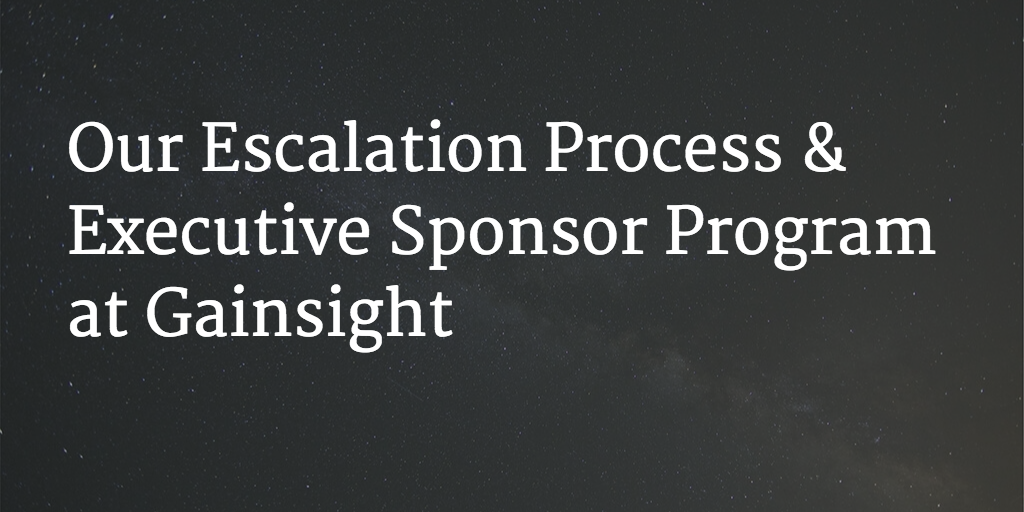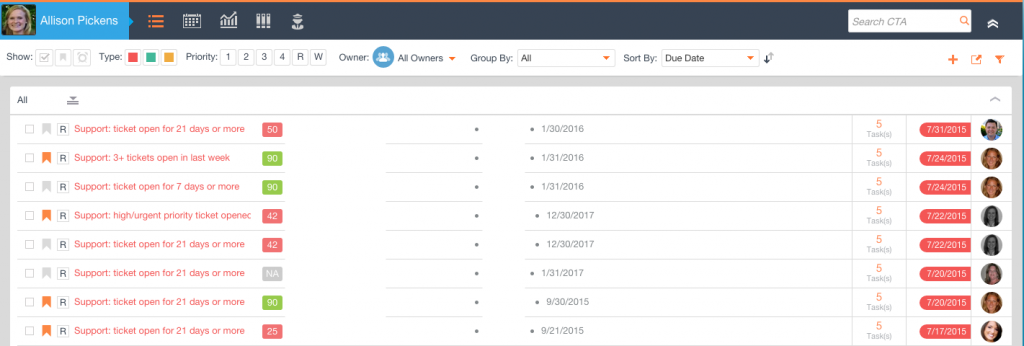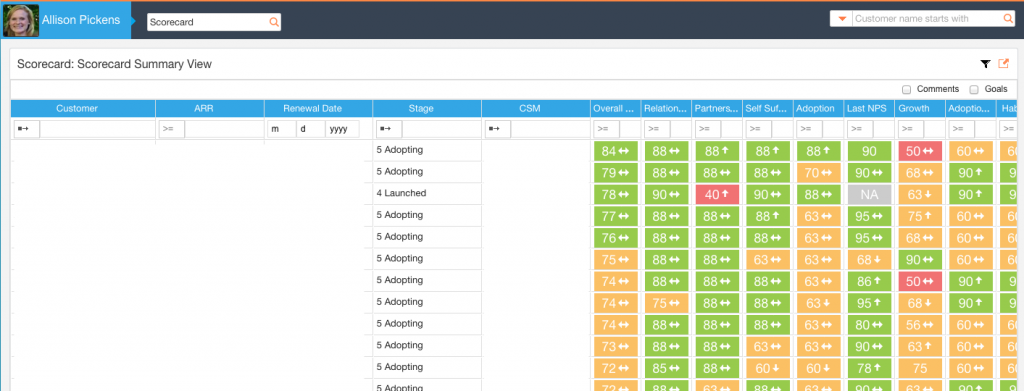Allison Pickens is VP of Customer Success & Business Operations at Gainsight
In a previous post, I shared how we manage risk at Gainsight, using Scorecards and Calls to Action (CTAs) for each of 8 risk areas. Even after we implemented this risk framework on our team, CSMs wondered, “Who do I ask for help when a risk arises?”
We wanted to involve senior executives in addressing these risks, but we also needed to avoid overburdening them as we scale. Instead, we wanted to empower our highly capable Team Leaders to be the “first line of defense,” and also enable CSMs to channel issues to the people who were best equipped to help resolve them.
With those goals in mind, we designed 2 processes:
- Escalation Process
- Executive Sponsor Program
(1) Escalation Process
Our Escalation process has one simple rule of thumb:
Flag a CTA when you need help.
Recall that you can flag a CTA by clicking on the icon on the left-hand side of a CTA, causing it to turn orange.
Here’s who can help when a CSM flags a CTA.
Escalation Level 1:
A. Team Leader
- We conduct 1-on-1’s using Cockpit. The team leader reviews all CTAs with the CSM, but focuses on Flagged ones.
- The CSM’s team leader immediately notices a CTA if the team member @-mentions the leader in the Chatter section of the CTA.
B. Rest of Team
- We have 2 team meetings each week. Our Tuesday meeting is focused on process improvements (we’re constantly innovating!). Our Friday meeting is focused on troubleshooting customer challenges. At that meeting, we discuss Flagged CTAs related to the risk areas that solely the CSM team is accountable for: Habits, Sentiment, and Company Risk. (Note that other teams at Gainsight are accountable for the other 5 risk areas, according to our RACI.) We also discuss Flagged CTAs related to upcoming Renewals. This meeting provides the CSM with a venue to brainstorm with others who may have encountered similar issues.
C. Other Post-Sales Teams
- At our Support Risk meeting on Wednesdays, CSMs work with our Support team to resolve Flagged Support Risk CTAs (i.e. when support tickets have high volume, urgency, or duration).
- At our Implementation Risk meeting on Fridays, CSMs work with our Services team to resolve Flagged Implementation Risk CTAs (i.e. when an implementation milestone is delayed).
D. Other Departments
- For other risk areas (Readiness, Product, and Bugs Risk), the corresponding departments review all Flagged CTAs in real time.
- Importantly, our Leadership Team meetings on Mondays include a 30-minute section on customers, in which we review all Red Scorecards for customers above a certain ARR threshold. As my last blog post explained, Scorecards update to Red when there is a Flagged CTA.
Level 2: VP of Customer Success (me)
The Team Leader can escalate an issue to me if s/he needs help, by @-mentioning me on the CTA. The Team Leaders know that I especially want to get involved when:
- An upcoming renewal is at risk
- The customer has a red Habits Scorecard – i.e. their adoption is very low. Typically this means that the customer needs a re-vamped strategy for adopting Gainsight.
- The Executive Decision-Maker at the account has left or changed roles (a form of Company Risk). In this case, I’ll want to align with the new executive.
Level 3: CEO
I will escalate to our CEO at times, typically when he has a prior relationship with a particular customer. I can also get his thoughts on a particular risk during our Leadership Team meeting on Mondays, as described above.
___
This process helps ensure methodical escalations from the CSM, to the Team Leader, to me, to our CEO. This might sound great in theory, but how do you make sure the team is bought into the process? Here’s how we did it.
We showed the team the ripple effects from flagging a CTA. We explained in detail the escalation levels above.
Step 2: Align on Strategy
We’ve talked for a while as a team about the principle that Scorecards represent the “source of truth” for whether a customer is at risk. If a customer has many green Scorecards, but the CSM believes that they are at risk, they should open a Manual CTA, causing a Scorecard to update to yellow, and then to red if the CSM chooses to flag the CTA.
Step 3: Make it Ingrained in Day-to-Day Meetings
Team Leaders started reviewing the Scorecard dashboard view with CSMs at the start of every 1-on-1, before diving into Cockpit. That way, the Team Leader can “cover all bases” by asking about any customers that are in green, which won’t typically show up in Cockpit.This process encourages CSMs to open risk CTAs whenever they detect a problem.
(2) Executive Sponsor Program
At one point in Gainsight’s history, we had an internal executive sponsor for every account, but this became unsustainable fairly quickly. We designed a new exec sponsor program that is intended to last only through the end of 2015, assuming that our Sales team performs at target, and assuming that each sponsor has the bandwidth to do 1 customer call per week. In January, we’ll design a new program for the first half of the year.
Here’s the Why, Which, Who, How, When, and What:
Why:
- To uncover latent challenges in our larger accounts
- Higher ARR or brand value means that more management attention is needed.
- We customize our approach for larger accounts, meaning that more intimate knowledge of the account is required than CSM team leaders generally have the bandwidth to acquire for every account.
- To give Gainsight executives across departments exposure to real customer issues in depth. This awareness helps our VP of Product design better products, helps our VP of Sales design a better sales process, etc.
Which: Accounts that surpass a certain ARR threshold, covering our Enterprise team (high-touch) and our Strategic team (super high-touch).
Who: Most executives on our leadership team, plus several Director-level leaders.
How: When there is a new customer above the ARR threshold, the Team Leader assigns an Executive Sponsor. S/he will take into account any pre-existing relationships, including whether an executive was involved during the sales cycle, as well as which executive is best suited to address the particular needs of that customer.
When:
- Enterprise accounts: 30-minute check-in 1x per quarter
- Strategic accounts: 30-minute check-in 1x per month
- Whenever the CSM, Team Leader, or VP (myself) asks for the sponsor’s help
What: Email the person at the account with the role “Executive Decision-Maker” to schedule the call. (We track roles for customer contacts in Gainsight.) Questions to cover:
- How are things going? What is going well? Poorly?
- Do you believe we are on the right path to meet your objectives when you bought Gainsight?
- Any feedback for us?
Note that we’re leveraging executives with the principal goal of uncovering challenges at the customer’s executive level, which may escape detection from both our Rules Engine and the CSM. The primary goal isn’t to escalate to sponsors. This ensures that execs aren’t swamped with crisis management, and also that we have another mechanism for detecting risks at our largest accounts.
You’ll need a couple of CTAs to run this program:
(1) CTA reminding the Exec Sponsor to reach out to the customer
– Owner: Exec Sponsor
– Timing: For Enterprise accounts, every 3 months. For Strategic accounts, every 1 month.
– Playbook: Include the list of questions described in the “What” section above.
(2) Add a task to the playbook for your New Customer CTA, so that an Exec Sponsor is assigned.
If you have questions about how to implement your own Escalation Process or Executive Sponsor Program, feel free to reach out to your Gainsight CSM or to Allison at apickens@gainsight.com. You can also follow Allison’s blog posts on Twitter at @PickensAllison.



